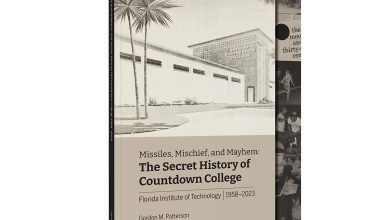Conquering the LSAT as a Prelaw Student
Kate Broderick, Global Strategic Communication ’14, Humanities ’10
The LSAT
The LSAT is a daunting hurdle all potential law students must conquer, but it is a challenge all Humanities-Prelaw students with the School of Arts and Communication can succeed in. An advantage of the Prelaw program with the School of Arts and Communication is its community of alumni that are willing to help talk you through their experience. When I was ready to apply to law school, I had several successful Prelaw graduates share their experience with me—now that I am an alumni, I want to pass on what I learned during my experience with the LSAT.
The LSAT can seem scary. Four points (as little as three questions on the test!) can bump you from a Tier I to Tier II law school, and may very well be the difference between a scholarship or a whopping student loan. The LSAT has four graded 35-minute sections and one ungraded writing sample. Scores range from 120 to 180. A “good” score depends on the type of school you are aiming for: the top schools require a minimum of 165, but a score over 170 is preferred. To put it in perspective, a score of 168 is the 95 percentile, meaning you scored higher than 95 percent of test takers. 164 is the 90th percentile; 150 is average.
The LSAT is a learnable, skill-based test. You can improve your score. There are two strategies for improving your grade: focusing on the logic games, or the logical reasoning (students tend to make the least progress on improving their score in the reading section—you are either a fast reader, or you aren’t. Don’t worry about this). With practice, you can get a perfect score on the logic games. Before I began studying, I missed about 12 questions on this section. After two weeks of intensive study, I could get a perfect score every time. The second section to focus on is the logical reasoning section because two sections of the test are logical reasoning. This means that even if you only improve your score by each section by three questions, times two sections, you can increase your total score by up to six points.
How to Study for the LSAT
Most potential law students take an LSAT prep course, which ranges from $300 to $3,000. I took a weekend course with Powerscore, with no prior study. To me, it was a wonderful investment that taught me the strategies I needed to learn how to effectively study for the LSAT. Alternately, you can hire a private tutor to focus on the areas you struggle with. A tutor ranges from $50 to $200 per hour. Every single person I know that has attended law school has had some form of professional prep before taking the LSAT. This is an investment in your future. Do not skimp on your LSAT preparation!
If you prefer self-study, there are a range of LSAT books available. Make sure they are up-to-date and use examples from real LSAT exams. There is no point wasting your study time on questions or material that will not be replicated on an LSAT exam. I worked through just about every LSAT prep book on the market, and can vouch for the KAPLAN and Powerscore Bible series. As a fellow Florida Tech Panther, trust me: these are where you want to be investing your time!
Lastly, the LSAC has released previous LSAT exams for study. Focus on practice exams after 1992 (they changed the question typed after the ’91 exams). This is a good indicator of your score, areas you need to focus on, and timing.
I recommend devoting a solid two months of LSAT preparation before taking the exam. During the first month, focus on understanding question types and don’t bother timing yourself. At this point, timing yourself will only cause unnecessary pressure and frustration. During the second month, start timing yourself using a wristwatch—not your cellphone or digital timer! When taking the LSAT, you will only be able to use an analog wristwatch. Familiarize yourself with the process early.
If you take the LSATs and it’s a disaster, don’t worry. You can retake it. Law schools even give you an opportunity to attach an addendum to your application saying why you had to retake the LSAT. Most schools only consider your highest score—that being said, most schools prefer you only take the exam twice.
When to take the LSAT
The LSAT is offered four times per year: October, December, February, and June. The February exam has a reputation for being the hardest exam—I don’t know if this is true or not, but I took the February LSAT and did feel disadvantaged in terms of the test content. There is one MAJOR disadvantage to the February LSAT: first, if taking the LSAT the year you intend to apply to law school, realize that about 20 percent of schools have application deadlines in December, or do not accept February scores. Second, a further 30 percent of schools have deadlines mid-February, meaning you will have ONE WEEK after the LSAT to submit your applications—without knowing your LSAT score. Because I did not know my final LSAT score, I applied to about 20 schools since I had no idea if my scores were in range for what schools. Typically, you receive your scores one month after your test.
Third, by waiting until February, you are entering the game fairly late. Most schools open applications in September. Half of the slots are already filled by the time you apply, meaning your scores have to be more competitive. Your LSAT scores are what put you on the law schools’ radar. After receiving my scores, I was bombarded by emails from schools offering to waive application fees if I decided to apply—nothing to sneeze at, as some schools are $100 to apply! I recommend taking the LSAT at latest the semester before you intend to apply, or the October test of your senior year. You can still get into law school taking the February test, but taking the LSAT earlier will make the application process easier.
The importance of the LSAT
Study for the LSAT. Invest in the books and the study courses. I was told the LSAT is 70 percent of your application and I believe it! After receiving my scores in mid-March, I was contacted by three top-10 schools waiving the application fee and extending the application deadline, which I had missed in December, a full three months if I applied. This would not have happened with a low LSAT score.
If you think the $3,000 course will help, take it. Don’t even question if it’s a good investment—it is. I read that the average law student graduates more than $200,000 in debt. A high LSAT score will unquestionably get you a full scholarship to a top-50 school—there is $200,000 riding on this exam! You are smart enough to score high. You’ve already learned what you need to succeed in your classes at Florida Tech with the School of Arts and Communication. Do not—not even for a single second—question whether it is worth the investment. It is a direct investment in your future. Also, instead of scrambling at the end, remember to give yourself the time to succeed and apply to schools with a strategy. Leave time for schools to court you. You are graduating from Florida Tech’s School of Arts and Communication as a prime applicant for law school. Invest in yourself and capitalize on this opportunity!





